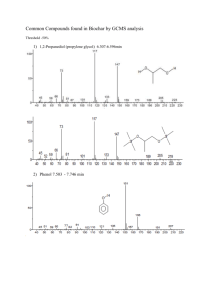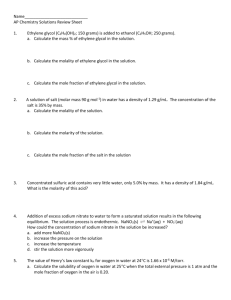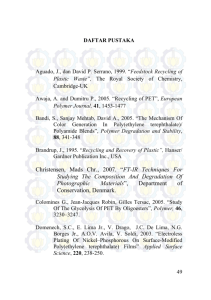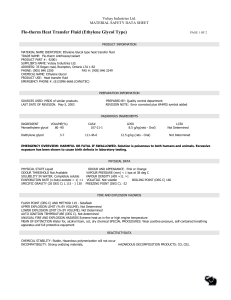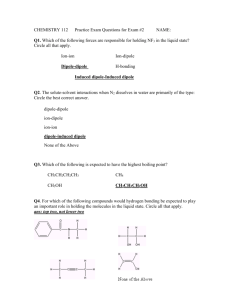III
advertisement
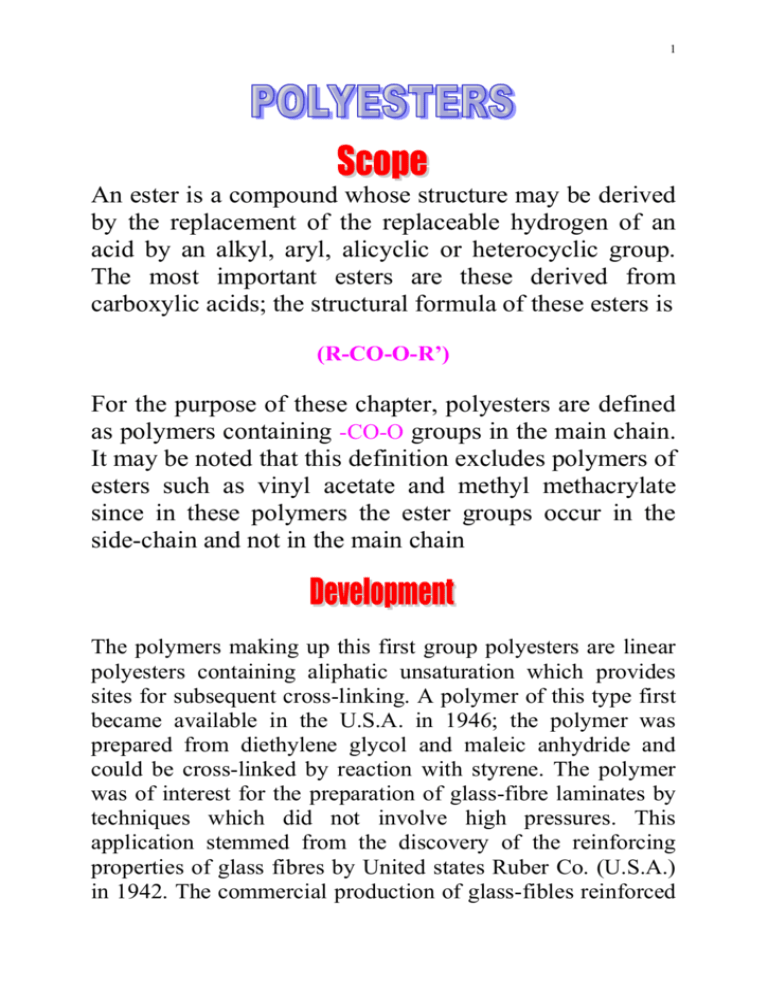
1 An ester is a compound whose structure may be derived by the replacement of the replaceable hydrogen of an acid by an alkyl, aryl, alicyclic or heterocyclic group. The most important esters are these derived from carboxylic acids; the structural formula of these esters is (R-CO-O-R’) For the purpose of these chapter, polyesters are defined as polymers containing -CO-O groups in the main chain. It may be noted that this definition excludes polymers of esters such as vinyl acetate and methyl methacrylate since in these polymers the ester groups occur in the side-chain and not in the main chain The polymers making up this first group polyesters are linear polyesters containing aliphatic unsaturation which provides sites for subsequent cross-linking. A polymer of this type first became available in the U.S.A. in 1946; the polymer was prepared from diethylene glycol and maleic anhydride and could be cross-linked by reaction with styrene. The polymer was of interest for the preparation of glass-fibre laminates by techniques which did not involve high pressures. This application stemmed from the discovery of the reinforcing properties of glass fibres by United states Ruber Co. (U.S.A.) in 1942. The commercial production of glass-fibles reinforced 2 polyesters laminates was firmly established by about 1949 and these composite materials have since become of great importance, particularly in such applications as boat hulls, lorry cabs, roofing panels and chemical plant. Unsaturated linear polyesters also find in thermosetting moulding compositions, casting resins and solventless lacquers. Linear unsaturated polyesters are prepared commercially by the reaction of a saturated diol with a mixture of an unsaturated dibasic acid and a “modifying” dibasic acid(or corresponding anhydrides). Propylene glycol is the diol most widely used for the manufacture of linear unsaturated polyesters; it is prepared by the hydration of propylene oxide O CH3-CH-CH2 +H2O CH3 HO-CH–CH2-OH Commonly the reaction is carried out without a catalyst at about 200C and 20 atmospheres. 3 Diethylene glycol (I) leads to greater flexibility although water sensitivity is increased and neopentyleneglycol (2,2-dimethylpropane-1,3diol)(II) gives polymers with improved resistance to thermal degradation. Polyesters with good alkali resistance are prepared from the diether of propylene glycol and bisfenol A (III) CH3 HO-CH2-CH2-O-CH2-CH2-OH HO-CH2-C-CH2-OH CH3 (I) (II) (III) Maleic anhydride is the most important unsaturated component used in the manufacture of linear unsaturated polyesters. It is generally obtained by the oxidation of benzene: 4 Fumaric acid (IV), the trans isomer of maleic acid is sometimes preferred to maleic anhydride as it is less corrosive and gives lighter-coulured products with slightly improved heat resistance. Chloromaleic acid may be used in the production of self-extinguishing resins. It is possible to cross-link unsaturated linear polyester chains directly one to another; however, reaction is slow and a low degree cross-linking is achieved. The limitations are overcome by the materials most commonly used to cross-link unsaturated linear polyesters in this way are vinyl monomers(X and XI). The addition of a liquid vinyl monomer to the polymer also leads to a reduction in viscosity and this facilitates the impregnation of glass-fibre in the preparation of laminates. 5 When polyester resins have been cross-linked they are rigid, infusible and insoluble. There are so many varieties of polyester resins now commercially available that is difficult to give typical values for physical properties of cured materials. Furthermore, polyester resins are mostly used in conjunction with glass fibre and the physical properties of the final products greatly depend on the type and quantity of glass fibre incorporated. This point is illustrated by Table given below. In which are given comparative values of some polyesters have good heat stability, showing little weight loss up to about 200 C. The electric insulating properties of cured polyesters are satisfactory for many purposes but the polar nature of the ester group results in a relatively high power factor and dielectric constant and so the use of resins in high frequency applications is limited. 6 Cross-linked polyesters are resistant to a wide range of organic solvents but they are attacked by chlorinated hydrocarbons(e.g., chloroform, ethylenedichroride), esters(e.g. ethyl acetate) and ketones(e.g., acetone and methyl ethyl ketone). The ester groups in the polymer provide sites for hydrolytic attack and strong alkalis cause appreciable degradation. The polymer is, however resistant to most inorganic and organic acids, with the exception of strong oxidizing acids. Although many linear saturated polyesters of high molecular weight (i.e. greater than 10 000) have been investigated only poly(ethylene terephthalate) is of significant importance. Ethylene glycol is prepared by the hydration of ethylene oxide O CH3-CH-CH2 +H2O HO- CH2- CH2-OH Ethylene glycol is a colorless liquid b.p. 197 C 7 Although poly(ethylene terephthalate) can be obtained by direct esterificarion of ethylene glycol with terephthalic acid, commertial processes are enviably based on the ester interchange reaction of the glycol with the dimethyl ester of the asid. The main reason for this preference is that terephthalic acid is diffucult to purify(since it sublimes at 300 C and is rather insoble) whereas the ester is ready purified by distillation or The preparation of poly(ethylene terephthalate) is based on the reaction termed ester interchange or alcoholysis). In this reaction, the alcohol residue of an ester is replased by another alcohol residue by treating the ester with an alcohol. A simple example of ester interchange is as follows: CH3COOCH3 + C2H5OH CH3COC2H5 + CH3OH If the liberated alcohol is distilled from the system as it formed, the reaction may be taken to completion. 8 In the preparation of poly(ethylene terephthalate) two successive ester interchange reaction are performed. Ester interchange occurs, the principal product being bis(2-hydroxyethyl terephthalate : The methanol which is formed is distilled off continuously. In addition of bis(2-hydroxyethyl terephthalate, small amounts of oligomers up to about the tetramer are formed; these have the general formula In the second step, the polymerization reaction proper, the product from the first stage is heated at 270-285 C with continuous evacuation to pressures below 1 mm Hg. Successive interchanges result in the formation of a polyester, as represent in the following scheme : 9 Poly(ethylene terephthalete) is a colorless rigid substance. Because of its structure regularity, the polymer ready crystallized and the physical properties of the bulk material are greatly affected by the extent of crystallinity, which , in turn, is largely determined by the previous history of the material. The filaments are thus rapidly cooled and are largely amorphous and are weak. The filaments are then drawn at a temperature above the glass-transition temperature ( 80 C), whereby molecular orientation and crystallinity are induced. Finally, the filaments are heated at about 200C under tension to five a dimensionally-stable material of maximum crystallinity. 10 Poly(ethylene terephthalete) glades suitable for injection moulding and extrusion are now avaible; the mouldings may be either amorphous of crystalline. The polymer intended to give amorphous moulding has a high molecular weight and is extremely pure; it thus has little tendency to crystallize, provided it is not exposed to temperature above 50 C. The completely amorphous material is transparent and has good impact strength. The polymer indented to give crystalline mouldings contains an added nucleating agent and so leads to a very highly surface hardness. The values of some properties of various forms of poly(ethylene terephthalate) which are given table below.
